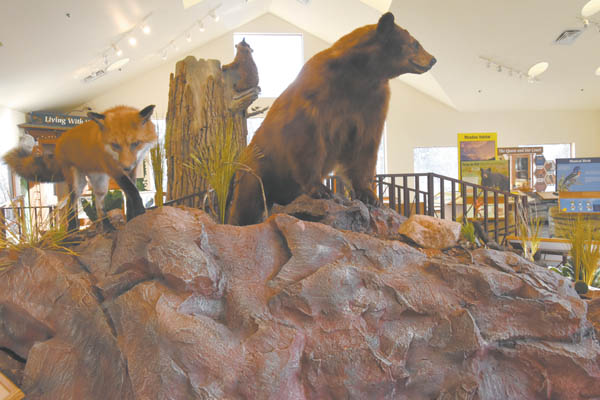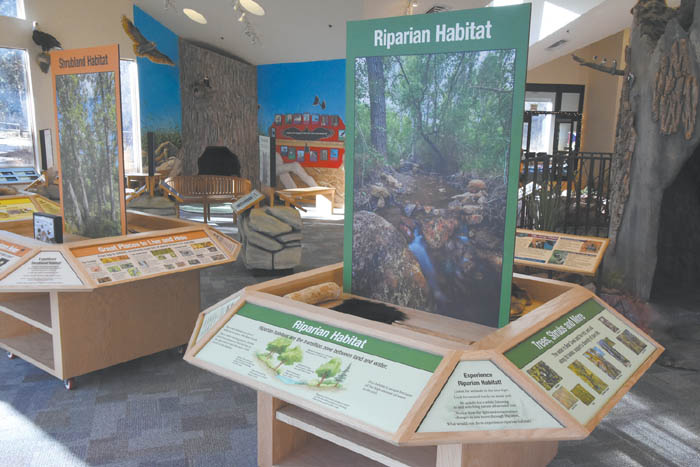Live cutthroats featured in new Bear Creek Nature Center exhibits
 A life-like black bear acts as unofficial greeter for the Bear Creek Nature Center. The bear, a holdover display - along with the nearby fox and the smaller bear on the tree - recently received taxidermy enhancements in conjunction with new exhibits (a few of which can be seen in the background at far right). Westside Pioneer photo
|
Located in El Paso County's Bear Creek Regional Park, the nature center is at 245 Bear Creek Road. Open Tuesdays to Saturdays, the county-owned facility does not charge for admission.
The exhibit updates were funded by $150,000 of tax funds, approved by county voters in 2014, and $100,000 of donations from individuals and organizations, according to Nature Center Supervisor Mary Jo Lewis. The county contracted with Condit Exhibits in Denver for the design and installation.
Condit in turn collaborated with the nature center, Lewis explained, to develop exhibits specific to the flora and fauna in the foothills nearby.
 As a featured new exhibit in the Bear Creek Nature Center, greenback cutthroat trout swim in a 300-gallon tank, their presence augmented by a mural on the wall behind. Westside Pioneer photo
|
The old exhibits mostly date back to 2002, when the center, which originally opened in 1976, was rebuilt after an arson fire destroyed the previous building in 2001.
In the renovation, a few of the older, popular exhibits remain, including “The Queen and Her Court” - an active, viewable honeybee colony with a tube providing the insects access to and from the outdoors.
People can also still walk on the short bridge over a simulated stream (now with an improved water pump), while a full-size black bear (benefiting from taxidermic enhancement and a repositioning to face the entry door) continues to reign over the interior.
A few other long-time, life-size stand-bys remain as well - a smaller black bear, a fox, a cougar, a golden eagle and a bald eagle.
The new fish tank includes the curious history of greenback cutthroat trout in this area. They were introduced to a small segment of Bear Creek (well upstream from the center) in the late 1800s, only to have that segment become the species' last remaining habitat.
In recognition of that fact, the U.S. Forest Service in 2014 undertook a somewhat controversial protection plan to close and reroute some trails near the habitat and to modify its streambed.
 The new exhibit "pods" illustrate the three main habitat types found in the foothills around the Bear Creek Nature Center. This photo shows two of the pods, Shrubland (left) and Riparian. The third is Meadow. In the background can be seen, between the pods, the new Cub's Corner for kids and (at far right) the center's entrance. Westside Pioneer photo
|
At the same time, greenback cutthroats are being reintroduced into Colorado's Platte River drainage, which is believed to have been their original home, Lewis elaborated.
Obtaining live greenback cutthroats for public display took some effort. After a federal permit was obtained - it helped that the exhibit has an educational purpose - the nature center worked with Colorado Parks and Wildlife to transport more than a dozen of the specimens from a hatchery in Leadville.
“This offers visitors and program participants a rare and special opportunity to get an up-close look at these threatened fish and learn more about their history,” Lewis writes in a release.
Behind the new fish tank, an original mural on roughly 100 square feet of wall depicts a stream scene intended to make the cutthroats in the tank look like part of it. The artist, Mickey Schilling of Fort Collins, also painted the wall around the new “Cub's Corner” in the southwest part of the exhibit area, Lewis noted.
Geared for the center's kids' programs, the “corner” is highlighted by a “three-dimensional tree [built into the wall] that invites visitors to crawl inside,” Lewis said. “A selection of children's books, puppets and an accompanying mural make this exhibit an imaginative and engaging space for young visitors.”
Here are other new features within the center's 8,900-square-foot interior:
Another station tells about acorn weevils, which are key to the Shrubland exhibit titled “The Mystery of the Acorn Holes.” “When people go out on the trail and see acorns with holes, they will make that connection,” Lewis said.
Overall, a major intent with the exhibits, Lewis emphasized, is to encourage “stewardship” of the natural environment.
Westside Pioneer article